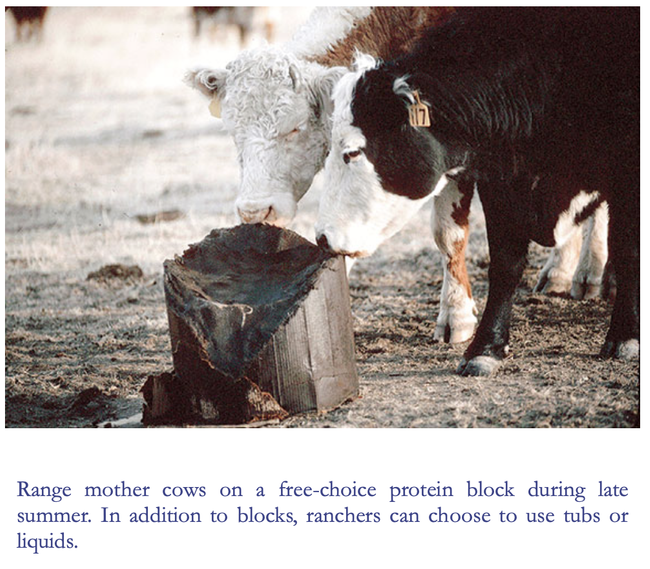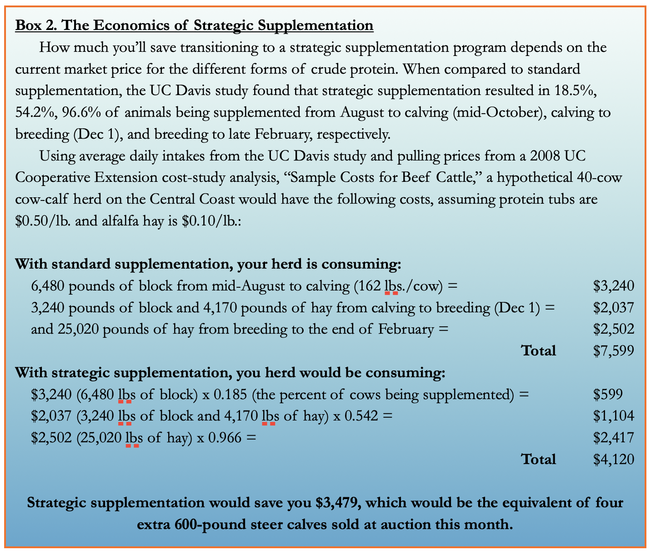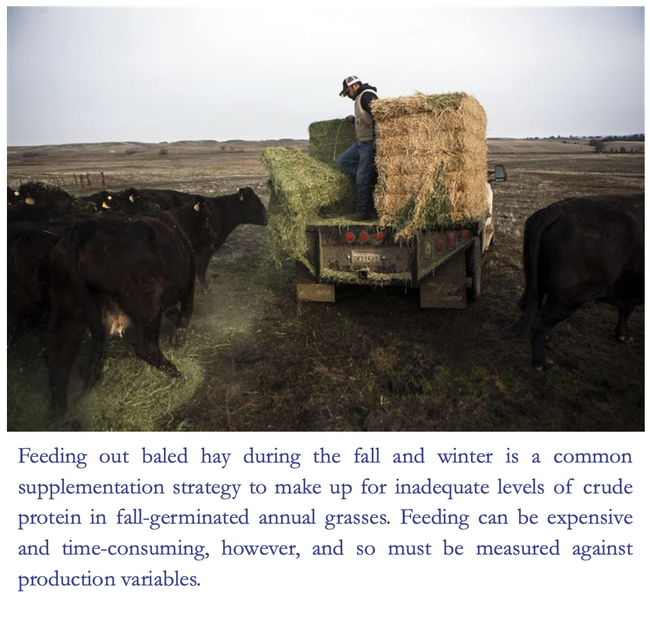Most of us expect that our cows will need some degree of supplementation to carry them through the dry season here on the Central Coast. Likely, you're putting out protein tubs or liquid supplements starting in the summer when the grasses begin to dry and transitioning to hay in the fall and winter when what green feed that does come up is washy. Of course, both of these strategies are meant to compensate for the lower than sufficient levels of crude protein (CP) available in the annual grasses that we find on our region's rangelands from summer through winter. 
It is assumed that this protein supplementation improves herd productivity by improving reproductive efficiency and increasing calf growth. The existing scientific literature, however, is surprisingly unclear about exactly how supplementation benefits mother cows or their calves. In an effort to clarify the mechanisms behind supplementation, researchers out of UC Davis conducted a five-year study that examined typical ranch supplementation practices and how they affected cattle grazing on Mediterranean-influenced California rangelands. More specifically, the researchers were interested in the long-term effects of both supplementation and stocking rate on pregnancy rate, calving interval, birth weight, weaning weight, live weight, body condition, and backfat—factors that fundamentally drive ranch profitability.
The experiment was conducted at one of the two research ranches that the University of California system operates—Sierra Foothill Research and Extension Center. The facility is a 6,000-acre working ranch in the Sierra Nevada foothills east of Sacramento. There, the researchers separated 260 British breed cows into three treatment groups: control, standard supplementation, and strategic supplementation. Each treatment group was then separated into high stocking rate and moderate stocking rate groups (see Box 1). The control group received no supplementation at all. The standard supplementation group was designed to mimic common supplementation practiced on California range by supplying protein when the available standing forage was inadequate to maintain body condition. Cows in this group had access to protein tubs from approximately mid-August until mid-November (average intake 2.7 pounds/day, 35% CP) at which point they were fed alfalfa hay until late February (average intake 6.95 pounds/day, 12% CP). And cows in the strategic supplementation group were examined periodically; those with a body condition score (one to nine scale, nine being fat) greater than 5.5 were placed with the control group (no supplementation) and cows with a body condition score less than 5.5 were placed with the standard supplementation group. The basic idea behind the strategic supplementation group was to see if cows that maintained good body condition throughout the production year could adequately breed back and raise a healthy calf without supplementation. If they did, ranchers could save a considerable amount per animal on the direct costs of supplementation. 
The results from the study are complex. With so many production variables (supplementation regime, age of cow, stocking rate), it was a difficult task to tease apart all the effects on pregnancy rate, calving interval, birth weight, weaning weight (205-day weight), live weight, body condition, and backfat. But let me share with you some key findings:
- Pregnancy rates:fall-calving cows without supplementation maintained their ability to re-breed so long as forage supply was adequate (i.e. under moderate stocking); however, if forage supply was low (i.e. under heavy stocking or drought) supplementation was required. On good forage years or in pastures that are conservatively stocked, protein supplementation is not required to maintain pregnancy rates in your mother cows.
- Calving interval: both the standard and strategic supplementation program served to decrease the calving interval (by 5 and 4 days, respectively); making a protein supplement available to your cows with low body condition, you can significantly shorten the calving interval in your herd.
- Weaning weight: the effect of supplementation on weaning weight was unclear; stocking rate, however, significantly affected 205-day calf weights. Conservative stocking, more so than a supplementation program, ensures high weaning weights in your calves.
Adequate reproduction (pregnancy rates) and weaning weights are the two most important factors in determining profitability in the cow-calf operation. This UC Davis study shows that nutrition modification can be used to alter herd performance, and hence ranch economics (see Box 2). Here are some key take-aways:
- It is critical to supplement your cows with protein to maintain pregnancy rates when forage is limited (low rainfall year or heavy stocking rates). There is no difference in pregnancy rates between cows that have sufficient forage and those that are supplemented (i.e. when it comes to pregnancy rates, you can compensate in low forage years with a protein supplementation).
- Cows supplemented based upon body condition (“strategic” supplementation) had similar calving intervals and gave birth to calves with similar 205-day weights as cows that were supplemented based upon forage quality or quantity (standard supplementation). In other words, strategic supplementation achieves similar production results and yet leads to fewer cows who need protein supplement (for example, between August and calving in late October, only 19% of cows required supplementation based upon body condition). This new supplementation program provides a method to decrease production costs while maintaining herd performance. With that said, sorting and separating mother cows based upon body condition and running them in different supplementation regimes presents some logistical difficulties. This program will only work if you have sufficient pastures and/or time to manage your breeding herds separately.
When it comes to ranch profitability, there is always a crucial tradeoff between how many cows you run per acre, their rate of successful pregnancy, calf weights at weaning, and protecting the range resource. You may find that running cows at more moderate stocking rates without supplementation and producing calves with higher weaning weights ends up being less profitable than running cows at elevated stocking rates, paying for supplementation, and producing more calves (per acre) that may have lower weaning weights. I would encourage you to experiment with the findings from this study and incorporate the practices that fit best your production system. 
If you would like to read the original research article, I would be happy to provide it. Send me an email or come by the office in Ventura. Here is the article's citation: Renquist, B. J., Oltjen, J. W., Sainz, R. D., Connor, J. M., & Calvert, C. C. (2005). Effects of supplementation and stocking rate on body condition and production parameters of multiparous beef cows. Animal Science, 81(03), 403-411.
